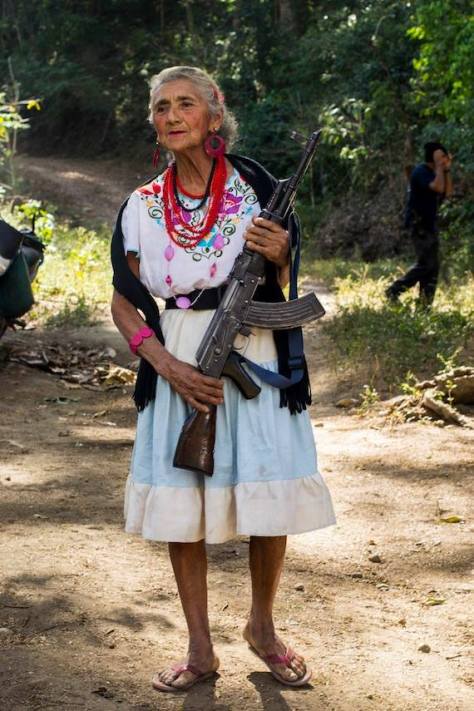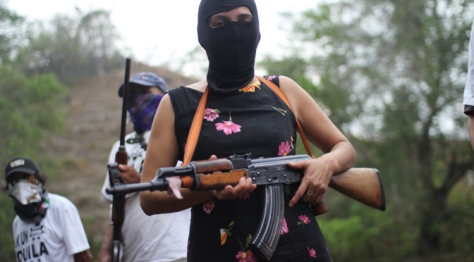Too often in the current anarchist milieu, certain ideological guidelines must be adhered to in order to “fit in” to the anarchist subculture. More the pity that many of these poorly thought-out notions are imposed from outside the anarchist critique and accepted as a given – especially by newcomers to activism and anarchist thought.
for a real-life example, see this post:
against the gulf war, against privileged campus activists
There are several examples that can be discussed here, but the one addressed in this book is pacifism, or rather the insistence upon pacifism as the one and only course of “action” to take in the fight for liberation by North American activists. Ward Churchill challenges this notion by spelling out quite clearly why the established Left’s demand upon non-violent “direct action” as the only reasonable course to take for social change is – to put it bluntly – cowardly, as well as ineffective.
For people serious about creating real change, this is a thought-provoking book. The impetus for it was a workshop Churchill gave at the Midwest Radical Therapy Association’s annual conference in 1981. After the initial workshop, entitled “Demystification of the Assault Rifle,” where Churchill explained and demonstrated how they functioned – through the display and break down of two Heckler & Koch assault rifles – he was censured. The organizers (excluding the ones who had actually attended the workshop and learned something) passed a resolution which barred anyone from carrying weapons into the conference. When Churchill asked how they would apply this rule if the police were to show up, a quick amendment was passed to exempt the police from having to surrender their weapons. The obvious hypocrisy was an embarrassment to the organizers who had invited Churchill to conduct the workshop and those who had actually attended it, thus the invitation for his articles.

Originally written for the radical therapy movement’s Issues in Radical Therapy (vol. 12, issues 1 and 2-1986), the articles have not seen widespread distribution since the mid-80s, although photocopies were passed around shortly after their publication. It is now available in book form – along with a new introduction by the author, and an afterword by Canadian activist Mike Ryan. The book has two main focuses.
First, it points out the failure of the North American “peace” movement’s ability to create any sort of lasting or “revolutionary” change in American society and the global repressive apparatus of capitalism. Second, it suggests that nonviolent activists undergo a sort of therapy to help them understand not only why oppressed people take up armed struggle, but also why it is impossible to create any sort of change in their circumstances without doing so.
Though the idea of some sort of “radical therapy” may at first seem simplistic and maybe a little silly, Churchill’s idea of therapy as he spells out in several chapters would indeed take North American pacifists out of their cozy, privileged environments and expose them to the very real threat of social, as well as state, repression. Basically, he speculates, the results would be one of three outcomes:
- the pacifists would wind up with a stronger idea of how nonviolent tactics do not protect the pacifists from violence and thus the pacifists might understand that bodily, financial and social harm is inevitable in genuine struggle to better conditions for oppressed people;
- the pacifists might come to understand why oppressed people often feel compelled to take up armed self-defense; or
- the pacifists would retreat to the safety of the suburbs from which they came, and give up the charade of activism before someone – themselves, for instance – gets hurt.
Regardless of one’s opinion of radical – or any kind of-therapy – this book provides valuable insights into the shortcomings of pacifism as a means of social change. Churchill rightly points out that several peaceful movements which pacifists use as examples of the effectiveness of their strategies were successful only because of the violence inflicted on the system by those outside the nonviolent movement. For example, Gandhi’s allegedly peaceful triumph in the struggle for the independence of India was overshadowed at that time by nationalist and religious violence which made the country ungovernable both during British colonial rule and afterwards. Not to mention the huge number of Gandhi’s followers who were subjected to crippling and even lethal violence by their opponents. The fact that India has had to split into several different nation/states since its independence speaks to the failure of Gandhi’s nonviolent philosophy – that and the fact that this has done little to curtail ethnic, caste and religious violence in those countries.
More immediately, the methods of Martin Luther King, Jr. are seen as particularly ineffective because the average income for African-Americans has declined since the beginning of the civil rights movement, while the rate of unemployment, the rate of incarceration, and the number of people living in poverty have all increased in the same communities during this period. The fact that some Black people have risen to positions of prominence and wealth is always used to create the illusion that the plight of minorities is a thing of the past, that we, as a society, have evolved, but the fact is that these few are often actively involved in the abandonment and/or subjugation of the less fortunate of their former communities.
A major focus of Churchill’s arguments are the attitudes of the male/white/middle class/students who make up the majority of activists in the various social change movements. Armed with college degrees, living in “nice” neighborhoods, and often working at a white-collar level, these people have no idea of the misery of the oppressed masses here in the U.S., and often have a victim-blaming attitude towards the people who rise up, either in self-defense or for their liberation from the state. This despite supposed solidarity with armed liberation groups in foreign lands. The thinking seems to be that people should fight against the might of the capitalist/military/industrial complex, as long as North Americans can still live comfortably in their cozy little communities.

Churchill does make a distinction between pacifists who have put their lives on the line for their beliefs and those who willingly cooperate with the police to assure that things don’t get out of hand, that no one gets hurt, and that any arrests made are primarily symbolic, for acts of symbolic civil disobedience. Still, the results of stronger acts of nonviolent resistance result in long prison terms, if not actual physical harm – even death – which not only discourages emulation by career-minded activists, but can remove the participant from the field of contest. In the end, even these bolder pacifist actions seldom achieve their goals and more often only delay or divert the actions being challenged.
The above mentioned willingness to cooperate with the police to keep activists and actions from “getting out of hand,” or “going too far” is a subject which deserves much more inquiry. In the afterword by Mike Ryan, he delves deeper into this subject and examines how he has come to question his own activism. He spells out quite succinctly how much of what passes for oppositional actions not only does not have much effect on its targets, but actually reinforces the power the state has over its citizens, while projecting the public myth that their society is an enlightened one, where people are free to demonstrate their disapproval of their government’s actions. Any talk of escalating activities of resistance or non-cooperation with the police are not only ridiculed and hysterically denounced by peace movement leaders, but are oftentimes reported to the police – for the sake of keeping the peace (for the white/middle class/student guys).
Along with the introductions – a preface by former political prisoner Ed Mead and the author’s – Ryan’s essay gives those interested in examining the shortcomings of late 20th century activism much to think about, and marks a good starting point in the search for more effective means of struggle. This little booklet contains a lot of information, particularly in the form of footnotes (172 for Churchill’s essay and 43 for Ryan’s).
About the only negative I see is Churchill’s mistaking of peace and justice movements for revolutionary ones. I must admit that I made this mistake for years and that it caused me much consternation, both in trying to push for more than symbolic action, and for the social alienation which followed from being cast out of one activist group after another. I finally came to see how real social change could greatly upset the comfortable lives of many of the activists, which – of course! – was not at all what they had in mind. Churchill does differentiate between pies-and-just-us clowns and actual revolutionaries, but not enough, I think – at least not in this work. Perhaps because activists were not the primary audience he addressed in this essay.
He also takes a look at the passive attitudes of Jewish victims of the holocaust, noting how their passivity didn’t really do them much good. Though he doesn’t examine this thoroughly, he mentions how Jewish resistance could have – and in some instances actually did – hamper German war efforts, and could have greatly reduced the final body count of death camp victims. There are books that go into this subject at length, particularly in dealing with the breakout at Sobivor and the Warsaw ghetto uprising. I’ll give Churchill credit for having the cojones to breach the subject, just mentioning it here makes me feel uneasy, but it is something that must be questioned and examined by both sides of the pacifist issue. Again, Churchill’s book provides a good starting point.
In order to achieve our desires for a life free of subjugation, anarchists and those in sympathy with anarchist philosophy need to look beyond current ideologies, especially those imposed from without by our alleged allies. The insistence of non-violent resistance and symbolic civil disobedience as the only acceptable forms of protest by North Americans is certainly one of the ideological areas which needs to be explored, challenged and debated.
This review was first published in Anarchy: A Journal of Desire Armed
see also:
CIA Funds Nonviolence Training, FBI Sets Up Phony “Terrorist” Plots

wow! it’s hard for me to believe i’ve forgotten to add this book review from my past websites. i would say this caused more discussion than anything i’ve ever written. there was certainly a lot of debate over the issue of traditional, non-violent direct action versus attacks against the ruling powers. much of the debate was initiated by denunciations of firebombings carried out by the earth liberation front. there were very few voices speaking in favour of the arson attacks, and reading churchill’s book inspired me to share my thoughts on pacifism as well.
Pacifism as Pathology: Notes on an American Pseudopraxis by Ward Churchill (Arbeiter Ring Publishing, 2-91 Albert Street, Winnipeg, Manitoba, Canada, R3B 1G5, 1998) 176pp., $11.95 paper.
